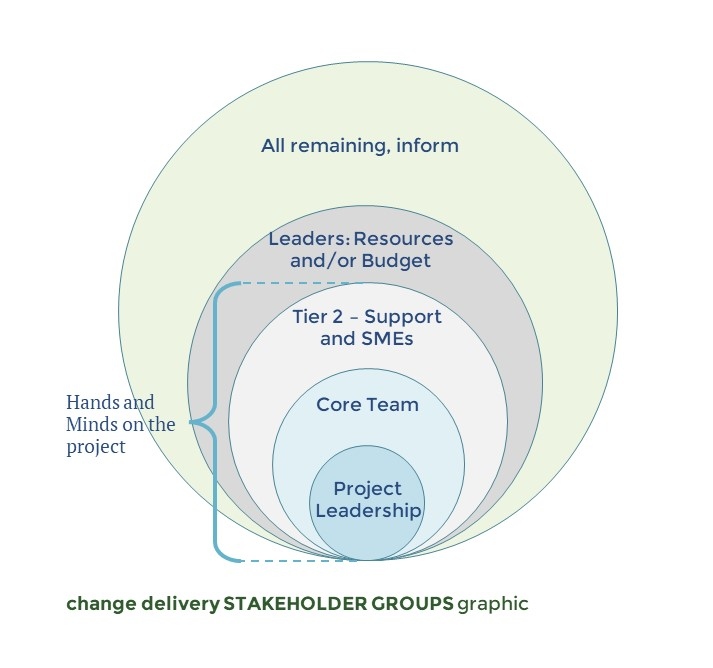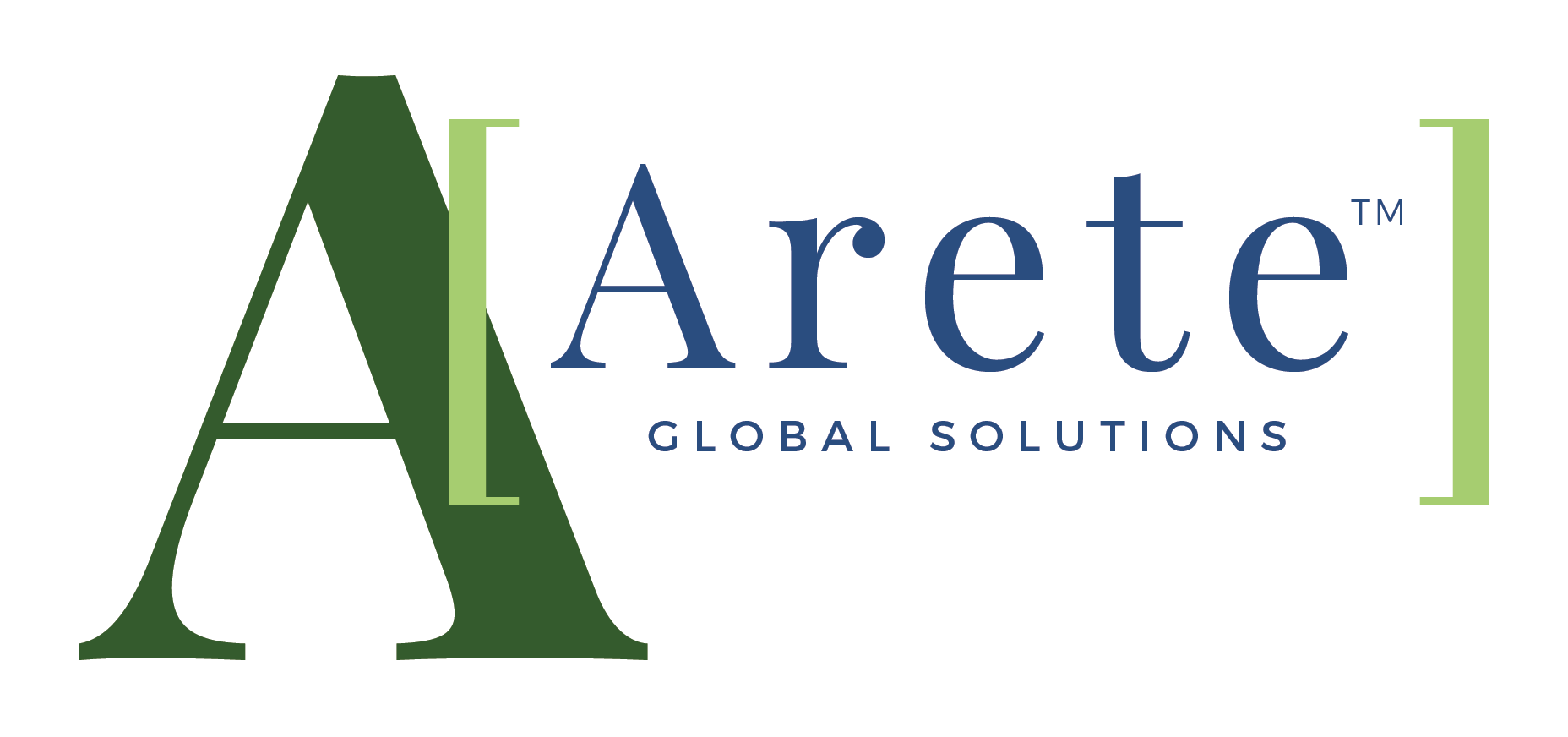
The path to communication excellence begins with identifying all people affected by the change.

Introduction
We all know that excellence in communication throughout any change initiative is critical to success. If you are a project manager or a change manager, communication is an integral part of your daily life.
As part of project management and change management methodologies there is a whole branch of work related to identifying, cataloguing, classifying, and engaging all of the people impacted by change. In project management, we typically focus on people participating in delivering the change(s), formerly under “Resource Management” and now under “Engaging with Stakeholders”. In change management, we focus on people impacted once the change goes live.
The PMI Project Management Body of Knowledge describes Stakeholders:
Stakeholders can be individuals, groups or organizations that may affect, be affected by, or perceive themselves to be affected by a decision, activity, or outcome of a portfolio, program, or project. Stakeholders also directly or indirectly influence a project, its performance, or outcome in either a positive or negative way.
Since most of my work involves a blended/integrated approach to project management and change management, I begin each project with a detailed and broad look at all the people impacted by the change. In this article, I will explore two different stakeholder communities and, hopefully, trigger deeper thinking by you about the communication needs of each. This is to help you on your journey to providing communications excellence in your upcoming projects.
Two Distinct Communities
Change management methodologies, such as Prosci, describe change management as preparing, equipping, and supporting individuals through their change journeys. They focus on strategic and disciplined communication for all people that will be impacted once the change goes-live. I fully explore “impacted” people for the complete lifecycle of the change from design through the “new” experience in the daily life of individuals. I consider two distinct stakeholder communities of people, and each further subdivided into groups, where each has its own communication needs.
The two stakeholder communities I call:
Change Impacted
Change Delivery
Change Impacted stakeholder groups, the recipients of change management’s communications, are people who will be affected by the change(s) going live. These can range from employees to customers or anyone who could be exposed to the change. The people affected may get new tools, processes, locations and/or relationships. They may or may not participate in building or delivering the change to the organization. By “delivering” I mean designing, building, configuring, implementing, or buying something that changes the environment in some way. Imagine the range of changes you have encountered over the last year and the many diverse types of change possible.
Change Delivery stakeholder groups consist of people who will participate in delivering the changes to an organization, customers, or the world. These groups may or may not be affected once the change goes live. For example, in my role as consultant for organizations, I help deliver the change and, unless I’m also a customer, may not be affected once it is in place.
Review of Communication Attributes
Before I discuss the two communities in more detail, I want to touch upon some of the standard communication attributes. These are the variables you should consider when you design your communications plan. It is not intended for this article to specify the attribute choices for the groups to be described later, but rather to review and raise the awareness of what to consider. This is not an all-inclusive list.
How the Communities Breakout
In this section, I will provide my breakout of groups within each community. You can begin to envision the needs for different communication strategies. Note that the concentric circle approach in the diagrams that follow is intended to show groups surrounding or outside other groups, each with reduced direct involvement or impact as you move outward from the center.
Change Impacted Stakeholder Groups
The graphic below shows a breakout of various groups that will be impacted once the change goes live. Credit for the conceptual framework goes to Prosci and their thought leadership in the Change Management space.
As you see, I have very finely divided the groups. These divisions might work well for a large, complex change initiative for a large organization. In your environment, feel free to collapse as appropriate.

Group Explanations:
Besides collapsing groups to reduce potential communication redundancies, the scale of change or impact should also be considered. My narrow definitions fit best when a change may affect a single department or team, such as replacing a finance department’s technology. Contrast that with the replacement of the expense reporting solution at a company that affects all employees who ever have reimbursable expenses. Besides training and other needs, those who use it daily, weekly, or monthly would need a lot of communication. Those who don’t need it now should be informed and directed as to where to get more information for future use, as with any HR process.
Change Delivery Stakeholder Groups
The graphic below shows a sample breakout of various groups participating in change delivery. In my example, I show a large number of groups. This is intended to serve a complex case, and you will probably not need as many in your project. Each distinct circle may require different communication needs, but some can likely be combined.

Group explanations:
For communication planning, I combine the three groups under the heading of “hands and minds”. They are touching the project directly. Beyond these two groups are two more groups. Leaders, providing resources or funding, and everyone else. I separate these last two groups because the leaders may need a different frequency or level of detail of communications than everyone else.
Two Examples of General Communication Designs
For consideration of how to lay-out communication plans across the communities and groups, consider two general-purpose options, leveraging the attributes described earlier.
High-Frequency, High-Detail, High-Priority
Target Groups:
Communication Modes:
Low-Frequency, Low-Detail
Target Groups:
The main priority of these communications is to help promote interest and engagement, and maintain a healthy culture. Additionally, people not impacted upon rollout may be impacted later.
Consider Prosci’s ADKAR Model
I can’t provide any communication topic without touching on ADKAR.
When determining the communication plan for each community and subset group, leverage the ADKAR model. Prosci’s change management methodology provides the ADKAR model for understanding how people move through change and the best-practice support needs. The letters represent Awareness, Desire, Knowledge, Ability and Reinforcement. Each individual travels through the change transition lifecycle at a different pace. Using this model can help everyone get from current state to future state, with change adoption and sustainability.
Your communication plan, especially for change impacted groups, should use the ADKAR model as a roadmap. While Desire is each individual’s choice to support and engage in the change, it is highly influenced by how you handle the other aspects of the ADKAR model.
Wrap Up
In this article I have presented a detailed perspective of two communities of impacted people for any change initiative. Some during the building or delivery of the change and others after go-live. Project management is primarily focused on the delivery related people and change management is primarily focused on the after go-live individuals. These groups often overlap and communication excellence requires concurrent planning and execution for each. Ideally, you have an integrated approach to project and change management that, by definition, expects and follows this approach.
There are many models for addressing the complexities of communication. I hope that the information presented in this post is of help to you in achieving your own communication excellence. I welcome readers to share their techniques and experience, as well as comments on how these concepts might help you with a current or future project.
Additional Idea credit for this article goes to Alex Carter and his presentation at the PMI virtual experience 2021, “Stakeholders! Identifying, Prioritizing, and Engaging Them on Your Programs and Projects”, and Dr. Louise Harris, in her talk at Change Management Global Connect 2021, “How to Improve Stakeholder Engagement with Less Effort”.
Thanks to Athena for the Featured Image through Pexels.com

